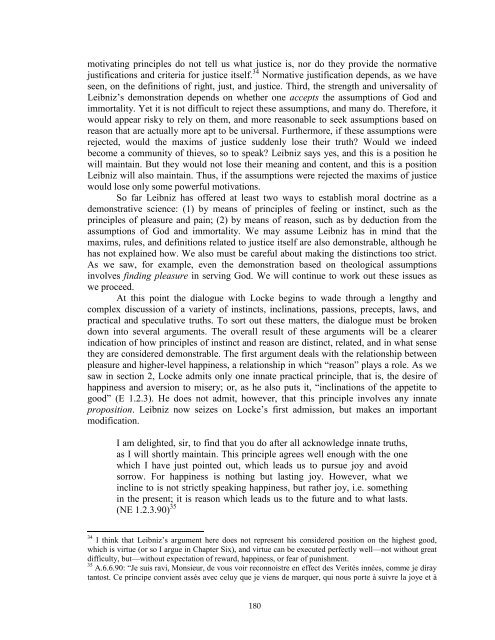Stony Brook University
Stony Brook University
Stony Brook University
You also want an ePaper? Increase the reach of your titles
YUMPU automatically turns print PDFs into web optimized ePapers that Google loves.
motivating principles do not tell us what justice is, nor do they provide the normative<br />
justifications and criteria for justice itself. 34 Normative justification depends, as we have<br />
seen, on the definitions of right, just, and justice. Third, the strength and universality of<br />
Leibniz’s demonstration depends on whether one accepts the assumptions of God and<br />
immortality. Yet it is not difficult to reject these assumptions, and many do. Therefore, it<br />
would appear risky to rely on them, and more reasonable to seek assumptions based on<br />
reason that are actually more apt to be universal. Furthermore, if these assumptions were<br />
rejected, would the maxims of justice suddenly lose their truth? Would we indeed<br />
become a community of thieves, so to speak? Leibniz says yes, and this is a position he<br />
will maintain. But they would not lose their meaning and content, and this is a position<br />
Leibniz will also maintain. Thus, if the assumptions were rejected the maxims of justice<br />
would lose only some powerful motivations.<br />
So far Leibniz has offered at least two ways to establish moral doctrine as a<br />
demonstrative science: (1) by means of principles of feeling or instinct, such as the<br />
principles of pleasure and pain; (2) by means of reason, such as by deduction from the<br />
assumptions of God and immortality. We may assume Leibniz has in mind that the<br />
maxims, rules, and definitions related to justice itself are also demonstrable, although he<br />
has not explained how. We also must be careful about making the distinctions too strict.<br />
As we saw, for example, even the demonstration based on theological assumptions<br />
involves finding pleasure in serving God. We will continue to work out these issues as<br />
we proceed.<br />
At this point the dialogue with Locke begins to wade through a lengthy and<br />
complex discussion of a variety of instincts, inclinations, passions, precepts, laws, and<br />
practical and speculative truths. To sort out these matters, the dialogue must be broken<br />
down into several arguments. The overall result of these arguments will be a clearer<br />
indication of how principles of instinct and reason are distinct, related, and in what sense<br />
they are considered demonstrable. The first argument deals with the relationship between<br />
pleasure and higher-level happiness, a relationship in which “reason” plays a role. As we<br />
saw in section 2, Locke admits only one innate practical principle, that is, the desire of<br />
happiness and aversion to misery; or, as he also puts it, “inclinations of the appetite to<br />
good” (E 1.2.3). He does not admit, however, that this principle involves any innate<br />
proposition. Leibniz now seizes on Locke’s first admission, but makes an important<br />
modification.<br />
I am delighted, sir, to find that you do after all acknowledge innate truths,<br />
as I will shortly maintain. This principle agrees well enough with the one<br />
which I have just pointed out, which leads us to pursue joy and avoid<br />
sorrow. For happiness is nothing but lasting joy. However, what we<br />
incline to is not strictly speaking happiness, but rather joy, i.e. something<br />
in the present; it is reason which leads us to the future and to what lasts.<br />
(NE 1.2.3.90) 35<br />
34 I think that Leibniz’s argument here does not represent his considered position on the highest good,<br />
which is virtue (or so I argue in Chapter Six), and virtue can be executed perfectly well—not without great<br />
difficulty, but—without expectation of reward, happiness, or fear of punishment.<br />
35 A.6.6.90: “Je suis ravi, Monsieur, de vous voir reconnoistre en effect des Verités innées, comme je diray<br />
tantost. Ce principe convient assés avec celuy que je viens de marquer, qui nous porte à suivre la joye et à<br />
180
















